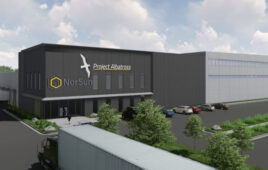Solar is prevailing in the Northeast following a string of passed legislation creating community solar programs in New England. States like New Jersey, Maryland and Maine all recently created community solar programs, and Pennsylvania may soon follow.
It varies by state, but many markets in the Northeast are still fledgling, with Maine, Pennsylvania, Rhode Island, Connecticut, New Hampshire and Vermont each reporting under 1 GW of total solar installed. The creation of these community solar programs will undoubtedly lead to development of ground-mounted solar projects, the primary setting for community arrays. The Northeast is a unique environment for such installations. APA Solar Racking reported that 40% of its PV structures and foundations sold are for projects in that region.

APA Solar Racking
What makes the Northeast a challenge for installers is a combination of its soil conditions, wind speeds and precipitation. The region is home to compacted soils with high presence of glacial till, cobble, boulders and bedrock, and given its longitude, the ground-mounts are also susceptible to frost jacking/heave.
“The frost in those markets is extremely deep,” said Josh Von Deylen, CEO of APA Solar Racking. “Those loads of a pull-out force that you would maybe see in Ohio of 3,000 pounds in Maine may be like 8,000 pounds, mainly because of the frost jacking forces, that foundation will see just a very drastic difference there.”
With the heavy presence of stone, installers need to be deliberate with foundation choices, selecting solutions that can work around or through those obstructions. Von Deylen said about 90% of the foundations purchased from APA for projects in New York and New England are ground screws, which are designed for rocky soil conditions.
“In Minnesota, you might have rock, cobble and glacial till, but that’s also going to be in soft soil,” he said. “So potentially, you can push past it and get through it a little bit easier. The New England market has very highly compacted, very stiff soils with all this rock in it, so it makes for a very hard scenario to look at the pile-driven foundations or helical foundations.”
The Northeast is prone to heavy snowfall, with several states receiving the most in the country, like Vermont, which averages about 90 in. annually. Plus, New England has a hilly topography and significantly less landmass compared to other regions.
“Flat area has really been utilized in development already, so anything that you’re going to see is a very rolling topography,” Von Deylen said. “High topography sites are very difficult for solar projects and definitely take a higher level of engineering and expertise to do the install vs. a lot of the rest of the United States.”
Despite its environmental qualities, the Northeast United States has policy backing its foray into significant new solar development.





Challenging soil conditions lead to creative solutions! As solar continues to expand these challenging soil condition will become a more prevalent obstacle. Many installers don’t see the benefits of using a rock drilling attachment to combat soil conditions but they can prove to be a versatile solution. With a WORD drilling attachments installers can switch between the installation helical and ground screws to conventional drilling to break through rock.
I find it interesting to see there is enough confidence in northern climates to take advantage of solar PV in States that are not “prime” for solar PV harvest.
The amount of technology and components that have been released to consumers in the past two years is explosive and industry changing. Single axis tracking that can be set up for East/West tracking allows northern climates with less sun hours per day to extend this time and generate more power each day. Bifacial solar PV panels allow back side light generation and (can) generate up to 20% more power a day. In regions with snow, the tracking could have snow shed controls, where the panels are set vertical to shed snow then set to track the sun. IF a hail storm cell passes through the area, impact sensors and programming could help tilt the panels for the least impact of the hail, saving panels from impact cracking. These technologies combined together will allow effective solar PV generation even on cloudy days. Couple this with large regional or local energy storage systems and a resilient renewable system is provided.
“The Northeast is prone to heavy snowfall, with several states receiving the most in the country, like Vermont, which averages about 90 in. annually. Plus, New England has a hilly topography and significantly less landmass compared to other regions.”
This “challenge” reinforces the use of tracking, bifacial and smart control programs to squeeze the most from every photon that falls to earth in the area. Energy storage seems more important here than in other places. Many of these small towns have only one feeder into town, if that goes out with a passing ice storm, being able to island for perhaps a few hours would allow the town the resiliency to store ahead and use later operations that could also, reduce demand charges from the utility.
2021 is looking good for alternative energy especially Solar. The big thing that caught my attention within the article is this line.. “What makes the Northeast a challenge for installers is a combination of its soil conditions, wind speeds and precipitation. The region is home to compacted soils with high presence of glacial till, cobble, boulders and bedrock, and given its longitude, the ground-mounts are also susceptible to frost jacking/heave.”
I’m curious how companies in that area are going to help people who install solar. Maintenance is probably going to be a major factor with the weather, but I’m ecstatic to see the installation boom continue to increase in these areas.